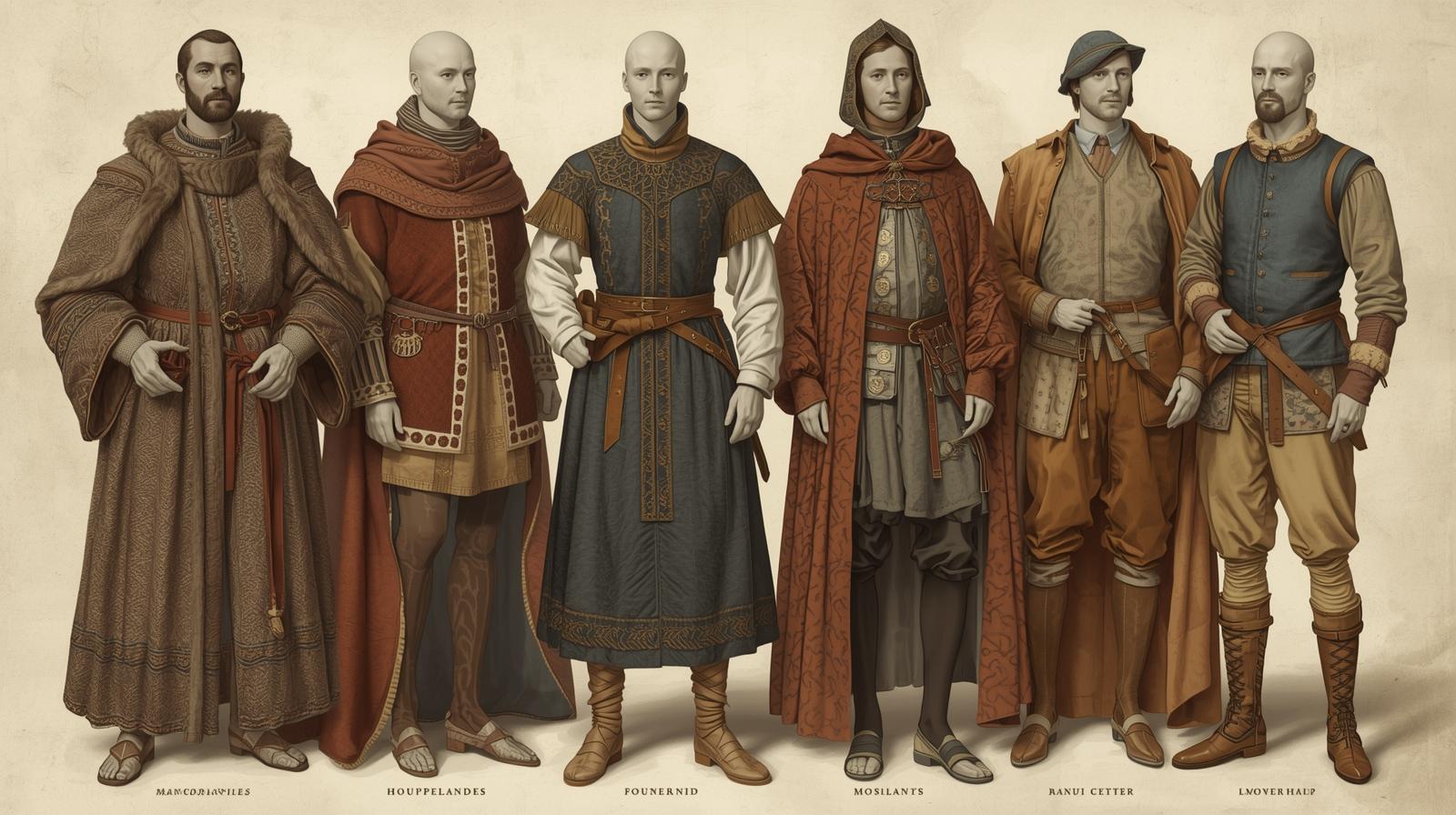Lifestyle
14th Century Clothing: A Detailed Look at Medieval Fashion and Style
Published
5 days agoon

The 14th century was a fascinating period of transformation not only in politics, art, and architecture but also in the world of fashion. During this era, clothing became more than just a necessity; it evolved into an expression of identity, class, and sophistication. The rise of tailoring, luxurious fabrics, and intricate accessories marked the 14th century as a turning point in medieval fashion. Both men and women began dressing with purpose, using garments to reflect social status, personal taste, and even regional culture.
In this in-depth exploration, we’ll uncover how 14th century clothing changed over time, what people wore across different social classes, the types of materials and colors used, and how these styles laid the foundation for future European fashion.
The social significance of clothing in the 14th century
In the Middle Ages, clothing wasn’t merely about comfort or modesty it was a language of status. The kind of fabric, color, and cut a person wore immediately revealed their position in society. Nobles and wealthy merchants used clothing to showcase power and prestige, while peasants wore simple garments that reflected practicality and modest living.
The 14th century saw the introduction of sumptuary laws, which dictated who could wear what based on rank and wealth. These laws ensured that the distinctions between nobility, clergy, and commoners remained visible. For instance, only the upper classes could afford garments made from silk or adorned with gold thread, while the lower classes dressed in wool or linen.
This deep social symbolism made fashion not just a personal choice but a matter of public display and royal control.
Men’s clothing in the 14th century
Men’s fashion underwent a remarkable shift during the 14th century. The loose, draped styles of earlier medieval times gradually gave way to more fitted and structured garments. The tailoring revolution had begun, and clothing was now designed to emphasize the body’s natural shape rather than conceal it.
1. The Cotehardie
The cotehardie became the centerpiece of men’s fashion. It was a snug, buttoned tunic that reached the mid-thigh or knee, often worn over a linen shirt and hose (tight-fitting leg coverings). Nobles decorated their cotehardies with intricate buttons, embroidery, or fur linings.
2. The Houppelande
By the late 14th century, the houppelande emerged as a grand outer garment for men of high rank. It featured wide sleeves, a high collar, and a flowing silhouette that projected authority. Made from rich materials like velvet and brocade, it often included elaborate linings and decorative trims.
3. Accessories and footwear
Men also paid attention to accessories. Belts were often worn over tunics, not just for function but as a fashion statement. Pointed shoes, called poulaines, became a symbol of elegance among the elite. Hats and hoods, such as the chaperon, added a touch of flair and distinction to men’s attire.
Women’s clothing in the 14th century
While men’s fashion became more tailored, women’s 14th century clothing grew increasingly elegant and sophisticated. The period marked the rise of fitted bodices, flowing skirts, and the use of luxurious fabrics that enhanced femininity and grace.
1. The Kirtle and Gown
At the core of women’s attire was the kirtle, a close-fitting underdress made of linen or wool. Over it, women wore a gown that could be sleeveless or have long, trailing sleeves. Wealthy women often layered multiple garments, creating depth and texture in their outfits.
2. The Surcoat
The surcoat, or “sideless surcoat,” became a defining feature of noblewomen’s fashion. Open at the sides with a fitted bodice and long train, it revealed the gown underneath and emphasized the waistline. Surcoats were often trimmed with fur or decorated with heraldic embroidery.
3. Headwear and accessories
Women’s headwear in the 14th century reflected both modesty and social standing. Married women often covered their hair with veils, wimples, or crespinets (netted headdresses). Among the upper classes, elaborate hats with decorative veils became popular, especially in court settings. Jewelry such as brooches, girdles, and jeweled belts further displayed wealth and taste.
Fabrics, colors, and dyes in 14th century fashion
Fabrics in the 14th century varied greatly depending on class and region. Wool remained the most common material for both rich and poor, but the quality differed significantly. Fine wool was reserved for nobles, while coarse wool was used by peasants. Linen, commonly worn as undergarments, offered comfort and hygiene.
For the upper classes, imported silks from Italy and the East were prized possessions. Velvet, satin, and damask fabrics became symbols of prestige. The wealthy often commissioned tailor-made garments from these luxurious materials, sometimes combining them in creative ways.
Colors held deep meaning in medieval clothing. Dyes were expensive, and some colors were restricted by sumptuary laws.
- Blue and red were popular among the wealthy, as they were made from costly dyes like woad and madder.
- Purple was associated with royalty and high clergy.
- Green and brown were more common among the lower classes due to their affordability.
These color choices weren’t only aesthetic but carried symbolic meanings blue represented loyalty, red symbolized power, and green was linked with fertility and renewal.
Clothing of peasants and the working class
While nobles enjoyed lavish wardrobes, peasants and laborers lived a simpler life. Their 14th century clothing was practical, durable, and suited to their work.
Men typically wore short tunics, hose, and cloaks made from wool or rough linen. Women dressed in long gowns with aprons and headscarves. Footwear was minimal simple leather shoes or wooden clogs. Despite the plainness, clothing was still carefully made, as most people had to sew or mend their garments by hand.
In colder months, peasants layered cloaks or mantles for warmth. The working class valued comfort and longevity over decoration, but they still took pride in neat, well-kept attire.
The role of tailoring and craftsmanship
The 14th century marked the birth of professional tailoring. As clothing became more fitted and complex, skilled artisans known as tailors began gaining importance. They measured, cut, and stitched garments that accentuated the body’s shape, marking a shift from draped to tailored fashion.
The introduction of buttons also revolutionized clothing design. They allowed for tighter fits and more decorative styles. Buttoned sleeves and bodices became fashionable among both men and women, making clothing more practical yet stylish.
Tailors often worked for the wealthy, creating custom garments that reflected the wearer’s personality and social standing. Their craftsmanship was highly respected and contributed to the evolution of European fashion as an art form.
Regional and cultural variations
Though Europe shared many common trends, 14th century clothing also varied across regions.
- In England, fashion leaned toward practicality, with simpler silhouettes and heavy wool fabrics suited for the colder climate.
- France became the center of luxury fashion, introducing extravagant cuts and embroidery that influenced the rest of Europe.
- Italy, with its access to fine silk and trade routes, emphasized elegance and vivid colors.
- In Germany and the Low Countries, clothing often featured structured designs with layered tunics and hooded cloaks.
Each region contributed unique touches, but together they shaped a rich tapestry of medieval fashion innovation.
The influence of the 14th century on future fashion
The clothing styles of the 14th century set the stage for Renaissance fashion. The emphasis on tailoring, structure, and individual expression carried over into the 15th and 16th centuries. Many garments like the houppelande and surcoat evolved into more elaborate forms, while the art of fashion design began to flourish in royal courts.
Perhaps the greatest legacy of this period was the concept of personal style. For the first time, people viewed clothing as an extension of identity, not just necessity. This shift in mindset transformed fashion into a cultural and artistic statement a tradition that continues to this day.
Key takeaways
The world of 14th century clothing was full of contrast from the richly embroidered gowns of nobility to the humble tunics of peasants. It was an era defined by innovation, symbolism, and craftsmanship. Tailoring emerged as a skilled art, fabrics became more refined, and fashion became a mirror of social hierarchy and personal expression.
Whether worn in royal courts or rural villages, clothing during the 14th century told stories of wealth, work, faith, and identity. It marked the beginning of Europe’s long and evolving relationship with fashion, setting the foundations for centuries of style to come.
FAQ:
1. What was the most popular clothing material in the 14th century?
Wool was the most widely used fabric, though nobles also wore silk, velvet, and linen.
2. Did men and women both wear layers?
Yes. Layering was common for warmth and style. Both genders wore multiple garments, often of different lengths and fabrics.
3. What role did color play in medieval fashion?
Colors represented social class and personal meaning blue for loyalty, red for power, and green for fertility.

A Start-Up with Patient Medical Stories

2 Story 2 Car Garage

100 Orange Juice Skip Opening Story

The Transformative Power of Technology in the Modern World

2 Year Mother’s Day Clothes: Adorable Styles to Celebrate the Day in Comfort and Joy

14th Century Clothing: A Detailed Look at Medieval Fashion and Style

Money Storm Slot Game: Where Every Spin Brings the Thrill of Fortune

Triple Double Diamond Free Games Slots: Classic Casino Fun with Big Wins

Best Running Trainers for Shin Splints: Find Comfort, Support, and Relief

Best Hair Products for Shine: Get That Healthy, Glossy Look Naturally

101 Warren Street New York City: Luxury Living in Tribeca

10 Provost St Jersey City: A Complete Guide to Modern Living

4 Seasons Nail Salon: A Place for Beauty, Relaxation, and Self-Care

2222 Jackson Ave Long Island City: A Modern Living Destination

6 Train Express Stops: A Complete Guide for New York City Commuters

Can You Get a Doctor’s Note Without Being Seen? A Complete Guide

Align Doctor Login Everything You Need to Know in Simple Words

Cutting Hair Style A Complete Guide to Modern Trends, Techniques, and Ideas

Bella Donna Hair Salon: A Blend of Style, Elegance, and Care

1920s Paris Business Women: The Bold Voices That Redefined Feminine Power

A Start-Up with Patient Medical Stories

2 Story 2 Car Garage

100 Orange Juice Skip Opening Story

The Transformative Power of Technology in the Modern World

2 Year Mother’s Day Clothes: Adorable Styles to Celebrate the Day in Comfort and Joy

14th Century Clothing: A Detailed Look at Medieval Fashion and Style

Money Storm Slot Game: Where Every Spin Brings the Thrill of Fortune

Triple Double Diamond Free Games Slots: Classic Casino Fun with Big Wins

Best Running Trainers for Shin Splints: Find Comfort, Support, and Relief









